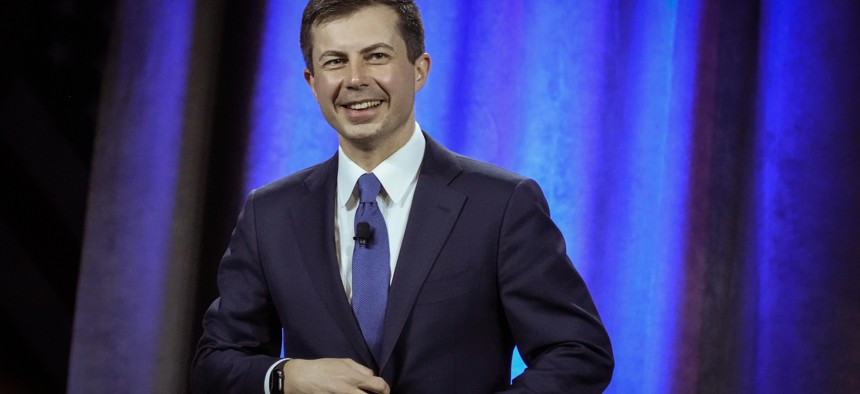How the Biden Administration is Trying to Speed Up Funding for Big Infrastructure Projects

U.S. Secretary of Transportation Pete Buttigieg speaks at the National League of Cities Congressional City Conference on March 14, 2022 in Washington, D.C. Drew Angerer/Getty Images
States and localities will be able to apply for three major infrastructure grant programs totaling $2.9 billion through a simplified process using one application.
The Biden administration wants to ease the process for states and localities to get federal money to build major infrastructure projects, so it’s simplifying the application for securing those funds.
The administration will let those governments apply for three major infrastructure grant programs with a single application. All told, the federal government will dole out $2.9 billion through those programs.
“Until now, we had limited ability to make awards beyond a certain level, or to support projects with funding from multiple federal grant programs,” U.S. Transportation Secretary Pete Buttigieg said Wednesday when making the announcement. “Under this approach and with a major infusion of new funding, we have the capacity to greenlight more transformational projects.”
The three programs included in the notice of funding opportunity are:
- National Infrastructure Project Assistance grants, nicknamed “Mega” grants, for major projects that are too big for traditional grant programs. This is a new category of grants created by the infrastructure law Biden signed last year. These grants could, for example, provide funding for Amtrak to build new tunnels under the Hudson River between New York and New Jersey. Other types of projects that might qualify, according to the U.S. Department of Transportation, are “new rail and transit lines that improve equity and reduce emissions; and freight hubs integrating ship, train and truck traffic while improving environmental justice.”
- Infrastructure for Rebuilding America (INFRA) grants, which fund freight and multimodal projects of national significance.
- Rural Surface Transportation (RURAL) grants, another new type of grant created by the Infrastructure Investment and Jobs Act. The money in this program would be used “to improve and expand the surface transportation infrastructure in rural areas to increase connectivity, improve the safety and reliability of the movement of people and freight, and generate regional economic growth and improve quality of life,” the U.S. Transportation Department said.
In supporting documents, the department said that it is looking for projects that reduce greenhouse gas pollution, address environmental injustice, advance equity (“including automobile dependence as a form of barrier”) and create “good-paying” union jobs.
No Surprises
The goals are hardly surprising. President Biden and his transportation officials have long promoted them and have even tried to get state transportation agencies on board with their vision. But the administration has much more discretion to reward agencies that try to meet those goals in grant programs, like the ones opened Wednesday, than for the bulk of transportation funds that are distributed through formulas written by Congress.
The administration has been highlighting many of the funding opportunities available through transportation grants, as it touts the increased amounts of money available because of the new infrastructure law. Buttigieg and other officials have announced those opportunities to generate excitement for one of Biden’s signature accomplishments.
In January, for example, Buttigieg encouraged states and localities to apply for RAISE grants, which can fund a variety of multimodal infrastructure improvements.
Daniel C. Vock is a senior reporter at Route Fifty and is based in Washington, D.C.
NEXT STORY: 4 leading practices for delivering business through the cloud






